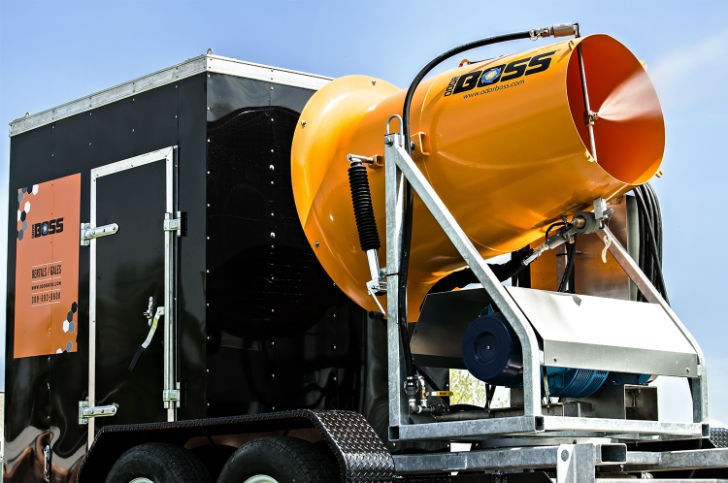
Dust Control Technology has announced a new heated model in its lineup of mobile equipment engineered to manage outdoor odor vapor from landfills, waste treatment facilities, livestock operations, paper mills, food processing plants and other operations that experience cold weather. The OdorBoss 60G with Heat by Dust Control Technology (DCT) combines an enclosure with insulation, heat tracing and internal heat generation to protect equipment and components during operation and storage in freezing conditions. Originally developed at the request of a customer in the Midwest, U.S., the design is a versatile, effective odor control mechanism suitable for year-round use.
The unit uses a mixture of water and odor treatment agents to distribute a specially-engineered mist over great distances using a powerful fan that propels the treatment into the air where it can attach to odor vapor. The result is a dramatic reduction in both short- and long-range odor without equipment clogging or downtime from frozen lines, helping companies remain compliant with environmental regulations and maintain good neighbor relations.
Impressed with the results during summer, customers asked for an outdoor odor control system that could withstand freezing temperatures and be used on a daily basis without interruption. Other odor control methods such as perimeter fence misting units and spray trucks can have serious issues in winter. Perimeter fence misting tubes freeze, rendering them useless for part of the year. Water spray trucks commonly experience ice buildup on the inside wall of the tank, along pipes and around nozzles, often requiring indoor storage to thaw, potentially restricting operation.
Inspired by the company’s core line of industrial fan-driven dust suppression products, the OB-60G with Heat has been engineered to deliver a finer mist that is better suited to optimum odor control. Based on principles of matching the droplet size to the size of the targeted vapor, the system uses a special nucleator nozzle and a 10 HP air compressor to create an engineered fog comprised of millions of tiny droplets as small as 15 microns in diameter (approximately twice the size of a human red blood cell). The droplets hang suspended in the air for long periods of time as they attract and collide with odor-causing molecules, counteracting them in the process.
“The challenge was how to keep the whole system, from tank to nozzle, producing the same results in the Winter as at any other time of the year,” said DCT President Laura Stiverson. “Each liquid-bearing component is insulated, heat traced or both, to ensure that there is no disruption in operation during cold weather.”
Designed for Winter Conditions
The key for excellent odor control in many operations is the versatility and low maintenance that the OB-60G with Heat provides. Powered by a 480-volt power source, the special open-ended barrel design contains a powerful 25 horsepower fan that generates 30,000 cubic feet per minute (152.4 CMS) of airflow on one end, which propels the fog created by the Odor X Atomizer nozzle located at the other end. The device is mounted on a towable roadworthy trailer that is also fitted with a 500-gallon (1893 L) water tank housed in an insulated metal enclosure. The unit can run for as long as 16 hours on a single tank filling under normal operating conditions.
During operation, a 100-watt thermostatically-controlled heater keeps the tank and equipment within the enclosure well above freezing, while the atomizing nozzle, regulator and other exterior components are warmed by separate heating elements to assure consistent operation without ice buildup. The tank is wrapped in heat tracing and skirted with a wide insulated belt around the bottom. When not in use, operators can keep the genset running or choose the more cost-effective option of switching the power source from 480 volts to 120 volts and using a grounded extension cord to power the essential freeze prevention elements. Depending on the outside temperature, even the unheated enclosure will stay above freezing for several hours after shutdown.
Ease of Mobility
Fitted with a 2-5/16" Class III ball hitch, the unit can be quickly repositioned on its trailer to accommodate changing work locations or shifting wind patterns with a standard pickup truck or small skid steer. At just 8.8 feet (2.68 meters) wide, 19.8 feet (6.03 meters) long and 8.4 feet (2.56 meters) tall, it can be easily positioned in places where most spray trucks cannot reach. Using the touch screen panel housed in a protective NEMA 3R cabinet, operators can set the unit to be aimed precisely where odor concentrations are highest or used as a powerful perimeter barrier with an extremely wide dispersal area using the standard 0-359° built-in electric oscillator and 0-50º vertical adjustment.
“With the severe weather protection, our environmentally-friendly additives and a low cost of operation, we anticipate this will become an industry standard,” Stiverson concluded. “We have designed what I believe to be the most versatile and effective airborne odor control system currently on the market.”



